|
Some believe that Lincoln’s assassin was not killed by Union soldiers, but escaped and lived until 1903. 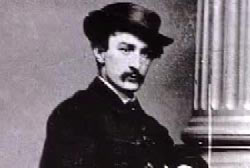 John Wilkes Booth 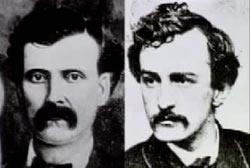 John St. Helen and John Wilkes Booth CASE DETAILS 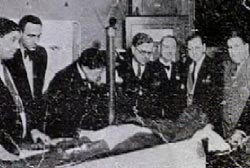 Autopsy revealed similarities between men In April of 1865, after President Abraham Lincoln was assassinated, two thousand Union troops searched for the killer: an actor named John Wilkes Booth. On April the 26th at 4:00 AM, soldiers surrounded a tobacco barn on Garrett Farm, near Port Royal in Virginia. They had information that Lincoln’s assassin was inside the barn. A man surrendered, but it was not John Wilkes Booth, but 21-year-old David Herold, known to be one of Booth’s co-conspirators. Lieutenant Edward Doherty decided to smoke Booth out by setting the barn ablaze. The soldiers were under strict orders to take Booth alive. But as the troops moved in, a sergeant shot a man who was hiding inside. Two soldiers dragged the body from the inferno, but was it really John Wilkes Booth? Historian Nate Orlowek doesn’t think so:
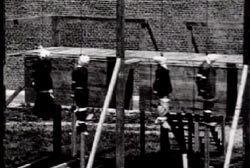 Four of Booth’s co-conspirators were hanged Those who challenge the official account believe that in the confusion following the Civil War, evidence may have been recorded incorrectly or perhaps even covered up. Even some high-ranking military officers questioned the official story of Booth’s death. In the early 1900s, John Shumaker, the army’s General Counsel to the Department of the Army wrote: “The evidence put forth by the government to support the conclusion that the body was that of John Wilkes Booth was so insubstantial that it would not stand up in a court of law.” Nate Orlowek and Dr. Arthur Chitty each spent years independently studying the Lincoln assassination. According to Dr. Chitty, they arrived at the same conclusion:
Historian James Hall disagrees and cites a 40-page statement made by David Herold to government investigators just 36 hours after Herold’s arrest:
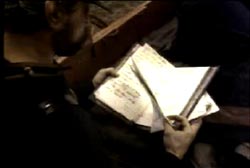 Booth’s papers were found in the Garrett barn Dr. Chitty claims Herold was pressured into changing his story:
According to Nate Orlowek, other eyewitnesses also refuted the government’s identification of the man killed at Garrett’s Farm:
Every historical account says Booth’s hair was jet black. Eyewitness testimony about the red-haired man was supported by two other Union soldiers: Joseph Zisgen and Wilson Kenzie. Nate Orlowek says the men were friends with Booth in New Orleans:
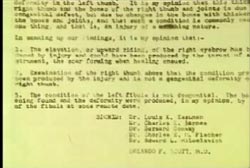 Six physicians recorded their findings in an affidavit Nate Orlowek says the men were told to keep the truth a secret:
Orlowek says the government autopsy was performed by a physician who was acquainted with Booth:
Dr. Chitty claims that, like the others, Dr. May was also pressured into lying:
Nate Orlowek sites a lack of documentation:
The body was secretly buried in the basement of the Old Naval Prison in Washington. But if John Wilkes Booth was not killed at Garrett’s barn, then what happened to him? In 1865, the government moved quickly to close the books on the Lincoln assassination. The trial of John Wilkes Booth’s co-conspirators resulted in four hangings and three life sentences. The details of the conspiracy were classified as “secret” and hidden away. Today, some experts believe that Booth actually escaped, and that he lived in the South under assumed names for another 38 years. In 1907, an attorney from Texas named Finis Bates published a book, called “The Escape and Suicide of John Wilkes Booth.” In its pages, Bates claimed that he learned the true story of Booth from a man named John St. Helen of Granbury, Texas. In 1877, when John St. Helen was seriously ill and afraid he was about to die, he made a startling confession to Finis Bates. He said his real name was John Wilkes Booth. Nate Orlowek:
St. Helen explained that all the bridges out of Washington were closed after nightfall and heavily guarded. But he had been given a password that allowed him to cross. According to Nate Orlowek, one of the guards on duty that night, a man named Frederick Demond, wrote a letter that supports this account:
Not everyone who was on the bridge that night agreed. Author and historian James O. Hall:
Booth had broken his leg while fleeing. After secretly seeing a doctor, he continued his escape hidden in the back of a wagon. Though he was a fugitive, Booth made the dangerous decision to take personal papers that could identify him as Lincoln’s assassin. At one point, says Nate Orlowek, it was believed that soldiers were approaching:
Booth sent a messenger back for the papers. But then another messenger arrived with bad news: Union soldiers were closing in. Booth could no longer wait for his papers and left immediately. It was the man sent back to retrieve Booth’s papers who was in the Garrett barn when it was surrounded by Union troops. This man carried Booth’s papers, so he was identified as the assassin. As it turned out, St. Helen didn’t die after his deathbed confession. He left town as soon as he recovered. Finis Bates was convinced the story was true. Historian James Hall isn’t:
Is it possible that John St. Helen was really John Wilkes Booth? A comparison of photographs does show a striking resemblance. In 1903, while staying at a boarding house in Enid, Oklahoma, Nate Orlowek says John St. Helen committed suicide by drinking a glass of wine laced with strychnine:
In 1931, six Chicago physicians examined the mummified body of John St. Helen and recorded their findings in an affidavit. They specifically noted a scarred right eyebrow, a crushed right thumb, and a broken left leg. John Wilkes Booth is known to have had all three of these unusual characteristics. Did John Wilkes Booth actually escape Union Troops only to kill himself 38 years later in an Oklahoma boarding house? Those who would know took that secret to their graves. Update: Though the story of Booth’s escape seems hard to believe, the Smithsonian Institute concluded it was worth a closer look. The Smithsonian even proposed exhuming the body of the man killed at Garrett’s farm, the man officially named as John Wilkes Booth. The Booth family agreed. However, a state court refused permission. The mystery surrounding Lincoln’s assassin still remains. Watch this case now on Amazon Prime in season four with Robert Stack and in season five with Dennis Farina. Also available on YouTube with Dennis Farina. Various seasons available now on Hulu. |
anon
awesome sauce
Amanda
In the mid/ late 1800’s taking pictures of corpses was very common. (children, outlaws, soldiers..) It seems to me inconceivable that the President’s assassin’s body was not photographed.
Gregory O'Neal
JWB got away, why else would the powers that be won’t allow exhumation of Edwin Booth because they know this will prove this so called conspiracy and cover up. I mean really, why else wouldn’t they allow it? Just like when you run away from the police makes you look that much more guilty!
Thomas
I too believe that Booth escaped justice and lived until 903 under the alias John St Helen and David George. In 2015, the National Museum of Health and Medicine denied the dna test because it was destroy a tiny fragment of his spinal bones. I mean what purpose is there to keep his bones. Makes me wonder 150 year old government coverup still today and that is why the museum rejected the tests??
Also if they could locate the mummy and use its dna, that would work.
Gregory O'Neal
I totally agree and the powers that be won’t allow exhumation of Edwin Booth because they know this will prove this so called conspiracy and cover up. I mean really, why else wouldn’t they allow it? Just like when you run away from the police makes you look that much more guilty!
J W Booth
I am John W Booth…
Benny Wells
The biggest question for me is lack of photos and no public viewing of the body . When you consider that there were numerous war photographers in the area and the fact that the people were fascinated by post-mortem photos as souvenirs , there should be at least a few postcards or something.
David Wright
As a Leadville historian I believe I am turning up enough evidence to show John Wilkes Booth did NOT die in Virginia, but lived his life out in Leadville, Colorado The government is notorious and expert at planting BS when they screw up, and the last thing they wanted in the official records was the multiple screw ups that allowed Booth to escape, and hence they offer “proof” that they “got their man”… I am continuing my research and am open to any documented evidence regarding this mystery.
Joy
Hi. I don’t know what eventually happened to the mummy that was going around with the circus. But Mr and Mrs. Harkins were friends with my mother. We lived on a farm near Kniman, Indiana. The Harkins couple owned (or rented) a place down the road and they stayed there between circus trips. My Mom often told me about helping carry the mummified body in or out of the Harkins house. I meet Mrs Harkins when I was a little girl in the early 1950s, when she would come to visit. I believe Mr Harkins may have already passed away by then. I never meet him. Mrs Harkins was living in the Chicago area at that time.
I don’t know if this is of any help to you or not. I also am very interested in this strange story….especially since I have a family connection from my childhood.
S. Grossman
I was vacationing (camping) in Leadville area about 20 years ago. I was in some type of antique store in the area and saw a poster with a supposed newspaper article that JWB was buried in the area. We went to the cemetery and searched. There was a small grave stone that had the inscription “Booth” on it. I can’t remember the date on the stone and it did appear very weathered and untended. I think it had “J.W.Booth” on it. There seems to have been many local tales about this and many of the residents have stories about the person and the grave site. Nothing conclusive but I was intrigued that there wasn’t more conclusive evidence or journalistic debunking of the claim. Regardless, it made for an interesting foray into alternative history and it brought some credence to the long-held rumor that it was not JWB who was killed in the barn in Virginia.
RLW
Everybody is looking for a conspiracy in everything. Booth died at Garrett’s Farm. If you want proof, look at the facts and the history recorded at the time. Booth and Herold had no warning and only minutes to decide what to do when the troops arrived to arrest them. They had no idea that they had been found out. No record of any type has ever been found to show an imposter was in that tobacco barn. Further, Sec. of War Stanton, was ‘obsessed’ with making sure the right man was killed, that it was indeed Booth. He was satisfied as were multiple authorities following the shooting of Booth. Give this conspiracy stuff a rest.
Dave
Franklin county TN library has a marriage license with the name John W Boothe being wed to a Louisa Payne.
The license is dated soon after the assassination of Lincoln.
Joanne Kline Hulme Gunvenhauser
Even today, it is clear to see that this is a coverup , many people involved in high places tried to cover their tracks. As a Booth cousin, we have tried to get the dna done but so called ” historians” fight against it all the time. One one needs to open threir minds and stop the whole stupid James O Hall stuff. Check out Historys’ Greatest Mystery on the History Channel on Dec. 5th 2020 for updates.
Bill Blaski
I believe John ST Helen was that of John Wilkes Booth. TB TB Road
Spitting image. Now in the case of Billy the Kid
I don’t believe Brushy Bill was Billy
Jean Kutzer
I grew up in Bandera, Texas. In high school our history teacher took us to the Frontier Times Museum to look at some documents left behind by a teacher at a local private school in the late 19th century. This man came to Bandera from the east and taught for many years. After becoming engaged he left suddenly when confronted by the young womans family who investigated his background and found him to be John Wilkes Booth. He left and was said later on he was headed for Oklahoma. The museum had some of his school work papers and we compared the handwriting. It certainly looked identicle. The museum today no longer has those papers unfortunately.
Pete
Because of the age of the case, “evidence” i.e eyewitness statements, testimony, army records, hearsay and conjecture can easily be misconstrued. However, if the Smithsonian Institute has concluded the findings are worth a closer look and the Booth Family have indeed agreed to exhume the body of the man killed at Garrett’s Farm, then surely the biggest question here is why has a state court has refused permission of exhumation? When a question of identity can easily be resolved with today’s forensic abilities, it seems strange that a state court would block the almost certain answer as to who this man was. Does this not fuel the flames of yet another conspiracy?
Lynda Taylor
This may sound obvious and they may have already thought of this but, since they aren’t allowed to take dna from the person buried as John Wilkes Booth to compare to his brother Edwin Booth, then why not ask to take dna from John St Helen? This would rule out John St Helen as being really John Wilkes Booth. If St Helens mitochondria dna does not match Edwin Booth then they are not brothers and that theory would be debunked.
Kay Ferraro
I believe you will find this article interesting.
http://library.indstate.edu/rbsc/neff/kate_scott_statement.html
Joy
I tried to access the website but it came up saying it’s not available. Hmmmm.
Lance
why wasn’t Booth body dug up and a dna test done on him I remember that his family gave permission but a court struck it down. Why not put this ridiculous story to rest once and for all
Robert Wallace
I have, for many years, been completely convinced of the fact, that John Wilkes Booth indeed DID escape capture; I Absolutely
Wholeheartedly stand with Nate Orlowek on the premise that someone other than Booth was in Garrett’s tobacco barn with Herold–and when he emerged Harold exclaimed: ” It’s not Booth “. . . that he subsequently was threatened that it had better be Booth.
There’s so many items of fact that placed together, one can’t help but clearly see there’s concrete doubt of Booth’s death in 1865.
The overriding contention that completely baffles me to no end–there are bone fragments in that one museum purported to be from the vertebrae from Booth. . .DO THE DNA on them and PROVE to us delusional, out of our mind and ” out to lunch ” conspiracy nuts that we’re all Wrong; WHY do those, like James O. Hall, every time { third time now I believe }, block the DNA testing on those remains. Do the test, prove they belong to Booth–and as Mr. Orlowek has declared, I will admit and believe what the History books have declared for 154 years now: Booth was killed at Garrett’s tobacco barn. Until then, I categorically believe he DID indeed ESCAPE! ! !
Robert Guthrie
When you compare the photographs of John Wilkes Booth and St. Helen you see that the nose is different, the ears and the way they sit on the head is unique to one another and since when did Booth have startled eyes like a deer caught in the bright headlights of a truck at night? Unless Booth went out and had plastic surgery the photos clearly shows they are two different men. John St. was a delusional character and Booth (want to be), just like crazy people going around thinking they are Napoleon or some historical figure.
Anonymous
Closely study the photographs of John St. Helen and John Wilkes Booth and see that they are two different men. Observe the nose; St. Helen’s was a bit smaller, the ears and how they set, the eyes; St. Helen had larger startled eyes. Even the chin is slightly different. Why are there those who tend to overlook such things?
Robert M. Wallace
I still stand by my earlier post on 20th June 2019–John Wilkes Booth was NOT shot to death at Garrett’s tobacco barn the 26th April 1865!
Two Super Awesome tomes to read on this truth are: ” Return Of Assassin: John Wilkes Booth ” by W. C. Jameson, and ” They Wanted Lincoln Dead ” by Troy Cowan; these two books are so cogent and uncover the false assumption that Booth died 12 days after shooting President Abraham Lincoln! They go in tandem with David Balsiger and Charles E. Sellliers’ ” The Lincoln Conspiracy “! These three are a ‘ must read ‘–and will truly open your mind! ! !
Mr Anonymous
Get a scanned copy of Bates’s entire book on Amazon Cloud.
LP
This information is very useful is there anymore